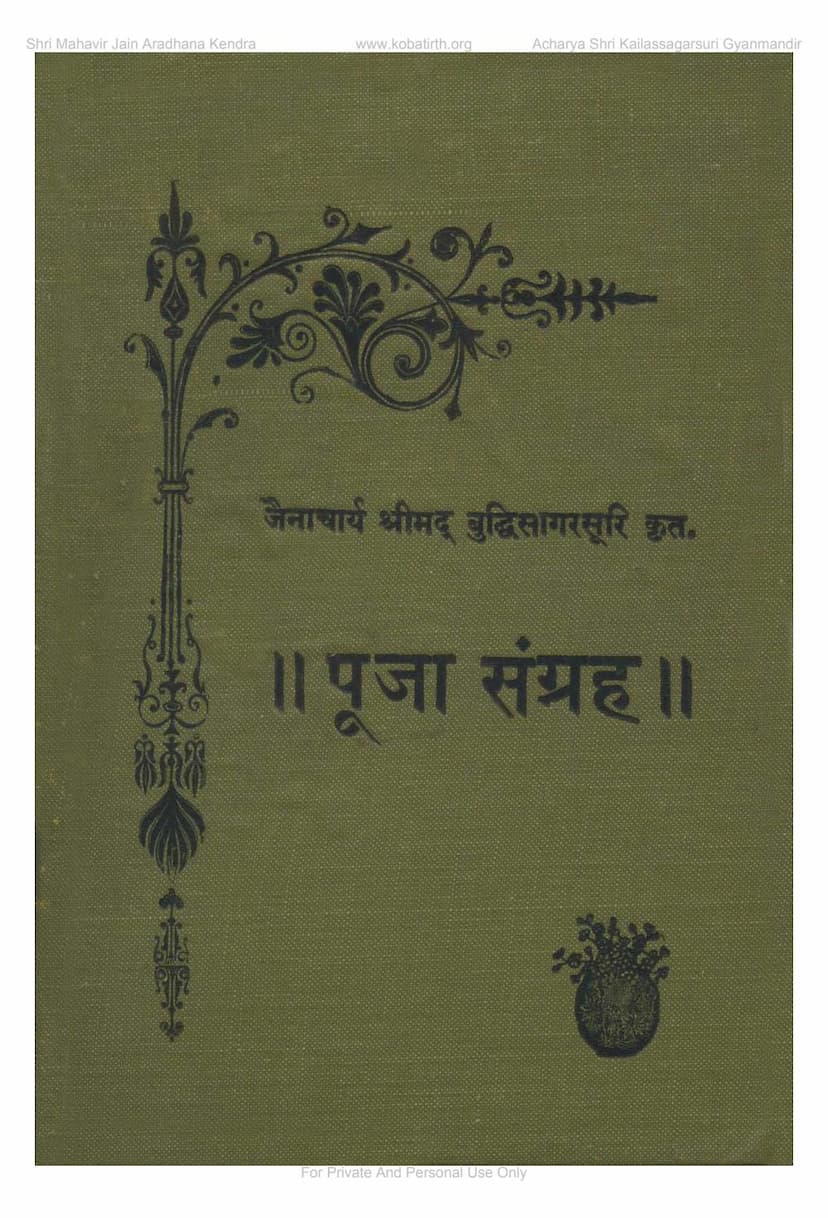Pooja Sangraha Part 2
Added to library: September 2, 2025

Summary
This document is a collection of Jain devotional songs and rituals, known as "Pooja Sangraha Part 2," authored by Acharya Shrimad Buddhisagar Suri and published by Adhyatma Gyan Prasarak Mandal. It was compiled with financial assistance from Jain families. The book contains various forms of worship (Pooja) dedicated to Jain Tirthankaras and revered figures, along with explanations and procedures for performing these rituals.
Here's a breakdown of the key aspects and content:
Core Purpose and Content:
-
Devotional Collection: The primary purpose of this book is to provide a comprehensive collection of Jain devotional songs (Pooja) for worship. These Poojas are meant to foster devotion, spiritual understanding, and character development.
-
Pooja Types: The book includes a wide variety of Poojas, each dedicated to specific deities, Tirthankaras, or spiritual principles. Examples include:
- Snatra Vidhi/Snatra Pooja: Rituals and songs for bathing and anointing the divine images.
- Navpad Pooja: Worship focusing on the nine supreme beings (Navpada) in Jainism (Arhant, Siddha, Acharya, Upadhyaya, Sadhu, Dharma, Darshan, Gyan, Charitra). The book includes both larger (Brihat) and smaller (Laghu) versions.
- Panchachar Pooja: Worship related to the five core conduct principles in Jainism.
- Visthhanak Pooja: Worship related to the twenty virtues or stages of spiritual progress.
- Dasha Vitha Dharma Pooja: Worship of the ten virtues practiced by ascetics.
- Chaar Bhavana Pooja: Devotion to the four auspicious reflections (Maitri, Pramod, Karuna, Madhyasthata).
- Daan Sheel Tap Bhavana Pooja: Worship of generosity, virtue, and austerity.
- Ashtang Yoga Pooja: Devotion related to the eight limbs of Yoga.
- Panchdha Yog Pooja: Devotion related to five types of Yoga.
- Panch Parmesthi Pooja: Worship of the five supreme beings (Arhant, Siddha, Acharya, Upadhyaya, Sadhu).
- Mahavir Janma Jayanti Pooja: Worship commemorating the birth of Lord Mahavir.
- Ashtakarma Sudenarth Ashtamakari Pooja: Worship to overcome the eight karmas.
- Shadavasak Pooja: Worship related to the six essential duties of monks.
- Ashta Prakari Pooja: Eight types of worship, likely referring to the offerings.
- Vastuk Pooja: Specific worship rituals, possibly for household consecrations or appeasement.
- Ghantakaran Mahavir Pooja: Worship of a prominent protector deity in Jainism.
- Guru Pooja: Devotion to spiritual teachers.
- Sattar Bhedi Pooja: Worship involving seventy categories of offerings or principles.
- Aarti and Mangal Deep: Songs of adoration performed with lamps.
-
Author's Intent: Acharya Buddhisagar Suri is highlighted as a learned scholar and yogi. His intention was to compose Poojas filled with profound devotion and spiritual knowledge. The collection aims to be accessible and beneficial for spiritual growth.
Key Themes and Concepts:
- Bhava Pooja vs. Dravya Pooja: The text distinguishes between "Bhava Pooja" (worship with inner feeling, devotion, and meditation) and "Dravya Pooja" (worship with material offerings like water, sandalwood, flowers, etc.). Both are considered essential aspects of devotion.
- The Nature of God: The introduction discusses various philosophical views on the nature of the divine, including both formless (Nirakar) and embodied (Sakar) forms, and how different religious traditions understand God. In Jainism, the Tirthankaras are considered perfected souls who are revered as embodiments of supreme virtues and are thus worshipped in their embodied state (as images) and their formless state (as pure souls).
- The Path to Liberation: The Poojas are presented as a means to purify the soul, develop virtues, and ultimately achieve liberation (Moksha) from the cycle of birth and death.
- Importance of Knowledge and Devotion: The text emphasizes that true worship involves both intellectual understanding (Gyan) and heartfelt devotion (Bhakti).
- Role of Gurus: The collection includes specific Poojas for gurus, acknowledging their crucial role in guiding disciples on the spiritual path.
- Jain Philosophy: The underlying principles of Jain philosophy, such as Ahimsa (non-violence), Aparigraha (non-possession), and Anekantavada (many-sidedness), are implicitly woven into the devotional practices.
- Cultural and Linguistic Context: The Poojas are primarily in Gujarati, reflecting the linguistic tradition of the region where it was published. The text also mentions the historical development of Poojas in Gujarati and the influence of earlier poets and scholars.
Compilation and Support:
- The book's publication was facilitated by donations from Jain individuals and families, as acknowledged in the "Nivedan" (Request/Introduction) and "Dhanyavad" (Thanks) sections. This highlights the community effort involved in preserving and disseminating religious texts.
- The publication date is noted as Vikram Samvat 1979 (1922 CE), highlighting its historical significance.
Overall Significance:
"Pooja Sangraha Part 2" is a valuable resource for Jain practitioners seeking to deepen their spiritual connection through devotional worship. It offers a structured approach to various rituals and provides lyrical compositions that evoke feelings of reverence and spiritual aspiration, all within the framework of Jain teachings and philosophy. The emphasis on the author's learned and devotional approach suggests a desire to make these practices both spiritually enriching and intellectually satisfying.